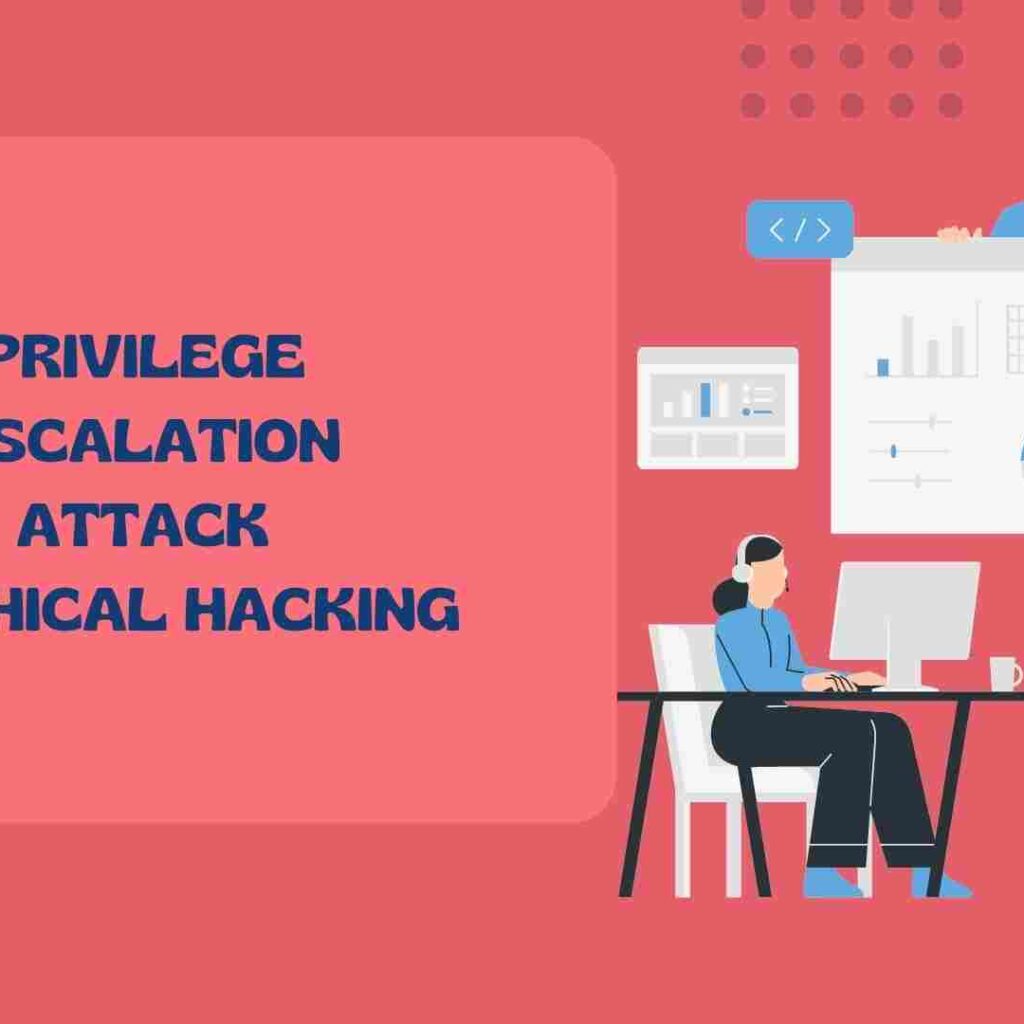Table of Contents
- Introduction
- How Do Privilege Escalation Attacks Work?
- Types of Privilege Escalation Attack
- Ways to Carry out Privilege Escalation Attack
- Prevention for Privilege Escalation Attack
- Conclusion
- FAQ
- Related Articles on Computer Network
- Related Articles on Cyber Security
Introduction
A privilege escalation attack is a type of attack in which an attacker attempts to gain elevated access to a system or network beyond what is initially granted to a user.
The attacker aims to gain increased privileges or permissions, such as administrative access or root privileges, which can give them the ability to execute arbitrary code or perform other malicious actions on the system.
This type of attack involves taking advantage of vulnerabilities in the system or network to gain additional privileges or permissions, such as administrative access or root privileges.
How Do Privilege Escalation Attacks Work?
Attacks that increase a user’s level of privilege often take advantage of flaws in software, setups, and access controls.
Every account that uses a system has certain rights. System databases, sensitive files, and other resources generally have restricted access for standard users.
Because they don’t try to get access beyond what they are allowed, users occasionally have too much access to sensitive resources without even realizing it. In other situations, attackers can escalate privileges by taking advantage of system flaws.
Attacks that increase a user’s level of privilege often take advantage of flaws in software, setups, and access controls.
Every account that uses a system has certain rights. System databases, sensitive files, and other resources generally have restricted access for standard users.
Because they don’t try to get access beyond what they are allowed, users occasionally have too much access to sensitive resources without even realizing it. In other situations, attackers can escalate privileges by taking advantage of system flaws.
Types of Privilege Escalation Attack
There are different types of privilege escalation attacks, including:
Vertical privilege escalation:
This occurs when an attacker tries to gain higher privileges on the same system or network. For example, an attacker with limited user privileges may attempt to gain administrative privileges to perform unauthorized actions on the system.
Horizontal privilege escalation:
This occurs when an attacker tries to gain the same level of privileges as another user on the same system or network. For example, an attacker may try to steal the login credentials of another user with administrative privileges.
Local privilege escalation:
This occurs when an attacker exploits a vulnerability in the system or network to gain elevated privileges on the local machine. For example, an attacker may exploit a buffer overflow vulnerability in an application running on the system to execute arbitrary code with elevated privileges.
Remote privilege escalation:
This occurs when an attacker exploits a vulnerability in a remote system or network to gain elevated privileges on that system or network. For example, an attacker may exploit a vulnerability in a remote server to gain administrative access to the entire network.
Ways to Carry out Privilege Escalation Attack
Exploiting software vulnerabilities:
Attackers can take advantage of vulnerabilities in the software running on the system or network to gain elevated privileges. This may involve exploiting a buffer overflow or other software vulnerability to execute arbitrary code with elevated privileges.
Misconfigured permissions:
Attackers can exploit misconfigured permissions on the system or network to gain elevated privileges. For example, if a user account has been granted unnecessary administrative privileges, an attacker could potentially use that account to escalate their own privileges.
Social engineering:
Attackers can use social engineering tactics to trick users into providing them with access to sensitive systems or information. For example, an attacker may pose as an IT administrator and ask a user for their login credentials, which can then be used to gain access to the system.
Password cracking:
Attackers can use password-cracking tools to gain access to user accounts on the system or network. Once they have access to a user account, they can potentially use it to escalate their privileges and gain access to sensitive information.
Prevention for Privilege Escalation Attack
Preventing privilege escalation attacks requires a multi-layered approach that includes both technical and procedural controls. Here are some of the best practices to prevent privilege escalation attacks:
Limit user privileges:
One of the most effective ways to prevent privilege escalation attacks is to limit the privileges granted to users. Users should be granted only the privileges they need to perform their job functions. This can be achieved by implementing the principle of least privilege, which means granting users the minimum privileges necessary to perform their tasks.
Regularly apply security updates:
Keep the operating system, applications, and other software up-to-date with the latest security updates and patches. This helps to eliminate known vulnerabilities that can be exploited by attackers to gain elevated privileges.
Implement strong authentication mechanisms:
Strong authentication mechanisms such as two-factor authentication (2FA) and multifactor authentication (MFA) can make it more difficult for attackers to gain access to user accounts.
Monitor system logs:
Regularly monitor system logs for unusual activities such as failed logins, changes in system configuration, and unusual access patterns. This can help detect privilege escalation attacks early on and allow for a prompt response.
Perform regular security assessments:
Regularly perform security assessments, including penetration testing and vulnerability assessments, to identify and remediate vulnerabilities that could be exploited for privilege escalation attacks.
By implementing these best practices, organizations can significantly reduce the risk of privilege escalation attacks and improve their overall security posture.
Conclusion
In ethical hacking, privilege escalation attacks are typically carried out to identify and fix vulnerabilities in the system or network.
By testing the system’s defenses against these types of attacks, security professionals can identify weaknesses and implement measures to prevent them from being exploited by real attackers.
FAQ
A privilege escalation attack is a type of attack in which an attacker attempts to gain elevated access to a system or network beyond what is initially granted to a user.
The attacker aims to gain increased privileges or permissions, such as administrative access or root privileges, which can give them the ability to execute arbitrary code or perform other malicious actions on the system.
There are different types of privilege escalation attacks, including:
Vertical privilege escalation:
This occurs when an attacker tries to gain higher privileges on the same system or network. For example, an attacker with limited user privileges may attempt to gain administrative privileges to perform unauthorized actions on the system.
Horizontal privilege escalation:
This occurs when an attacker tries to gain the same level of privileges as another user on the same system or network. For example, an attacker may try to steal the login credentials of another user with administrative privileges.
Local privilege escalation:
This occurs when an attacker exploits a vulnerability in the system or network to gain elevated privileges on the local machine. For example, an attacker may exploit a buffer overflow vulnerability in an application running on the system to execute arbitrary code with elevated privileges.
Remote privilege escalation:
This occurs when an attacker exploits a vulnerability in a remote system or network to gain elevated privileges on that system or network. For example, an attacker may exploit a vulnerability in a remote server to gain administrative access to the entire network.
Related Articles on Computer Network
- Introduction to Computer Networking | What is Computer Network
- What are Topology & Types of Topology in Computer Network
- What is FootPrinting in Cyber Security and its Types, Purpose
- Introduction to Cloud Computing | What is Cloud Computing
- Distributed Shared Memory and its advantages and Disadvantages
- What is VPN? How doe VPN Work? What VPN should I use?
- What is an Internet and How the Internet Works
- What is a Website and How Does a Website or web work?
- Introduction to Virus and different types of Viruses in Computer
- What is TCP and its Types and What is TCP three-way Handshake
- What is UDP Protocol? How does it work and what are its advantages?
- What is an IP and its Functions, What is IPv4 and IPv6 Address
- What is MAC Address and its Types and Difference MAC vs IP
- What is ARP and its Types? How Does it Work and ARP Format
- What is ICMP Protocol and its Message Format?


